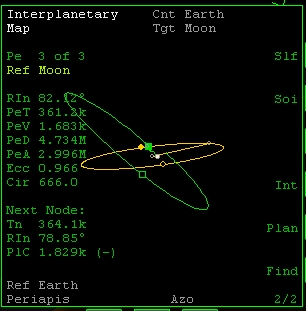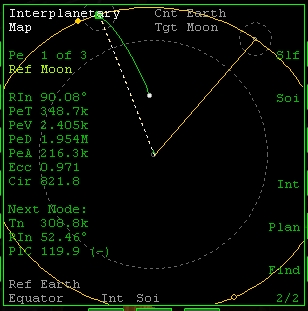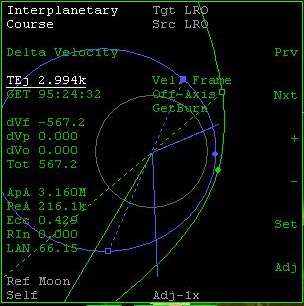Lunar Reconnaissance Orbiter part 2
LRO Targeting[edit]
Wait until the fuel purge happens at 32M above the earth. Switch focus to LRO. Select IMFD in both MFDs.
In the right MFD, click MNU, PG, and enter 0. Click Map, TGT, and enter Moon. Click Sel until Ref Moon is displayed in yellow letters. Click MOD 3 times and set Accuracy to Max. Click MOD twice to restore Map view showing EqI(equatorial inc) parameter.
In the left MFD, click MNU, then Course. Click Nxt 4 times so that Delta Velocity is highlighted, and click Set. Click TGT, and enter Moon. Click Nxt, then Set, and set TEj to 400. Click Nxt three times until dVf is highlighted. Click Set, and enter 0. In the right MFD click PG, then Plan. In the left MFD, adjust dVf, and dVp so that EqI and PeA in the right MFD are as close as possible to 90 degrees and 350k as possible.
Be as accurate as possible here. LRO is planning on avoiding a mid-course correction if possible. In orbiter, we will probably still have to do a small MCC.
When your adjustments are done, click Prv until TEj is highlighted and set it to 0. Click PG, BV, and AB. When the burn is done, click BV, and PG. In the Right MFD, click Plan to turn off plan mode.
Mid course correction/LRO[edit]
Wait until PeT is about 350k
In the left MFD set dVp and dVf to 0. In the right MFD, click Plan so that the green line turns blue. In the left MFD adjust dVp and dVf so that EqI and PeA in the left MFD are as close as possible to 90 degrees and 350k respectively When these adjustments are finished, click PG,BV, then AB in the right MFD. When the burn completes, click Plan in the left MFD so the blue line returns to green.
Be as accurate as possible, as this will be our last course correction for LRO.
Course correction/LCROSS[edit]
Switch focus to AV020Centaur. Select TranxX in both left and right MFDs
In the right MFD, click ++ to turn Maneuvre mode On. Adjust Prograde vel and Ch. plane vel so that on the Left MFD R. Inc is as close as possible to 0, and Pe Ratio is as close as possible to 1.0 Click VW on the right MFD for Target view. Use rotational thrusters to get the cross as close to the center of the target as possible. Press M to enable the dummy main engine, and use the numpad-+ key to burn the engine. Reduce the Rel V to as close to 0 as possible.
As an alternative to using the dummy main engine, after the Centaur is targeted with rotational thrusters, you can rotate the Centaur 180 degrees and use the LCROSS main engine numpad-- (minus) This will provide you with graphics of the engine firing in external view. (F1)
 View of what the LCROSS orbit inclination will be after the flyby. Taken after mid course correction.
View of what the LCROSS orbit inclination will be after the flyby. Taken after mid course correction.
Repeat these adjustments as necessary as you get closer to the moon.
orbit insertion/LRO[edit]
The LRO main engine is not strong enough to get it into a circular orbit in one try. It will take 4 burns over 12 orbits to achieve the initial 216km x 30km commissioning orbit, with periselene over the South Pole. The first burn is critical in that we must avoid a situation where we are "weakly captured" or not captured at all. The orbit eccentricity at the end of our first burn must be 0.8 or less.
When LRO's PeT is about 5k, select IMFD in the left MFD, and Orbit MFD in the right.
Click on the HUD button on the right MFD. Change the MFD to IMFD map mode. Set the TGT to LRO, REF to Moon. Click PG, then Plan. In the left MFD select IMFD course, then click on PRV and select Delta Velocity mode. Click REF and enter Moon, and click TGT, and enter LRO. Select dVp, and click on + or - until the EqI in the right MFD is 90 degrees. Click PG, BV, and AB. When this burn is finished, in the left MFD set TEj to 3k, and set dVf to -520. In the right MFD, select Orbit MFD. Set FRM to EQU, and PRJ to Ship. In the left MFD, adjust TEj (affects mostly PeA) and dVf (affects mostly ApA) until the PeA and ApA as shown in the bottom left of the left MFD are as close as possible to 216k and 3.16M respectively. Continue these adjustments until both parameters are as close as possible. In the Left MFD, click PG, BV, and AB.
When the burn is finished, LRO then completes 4 orbits at 3160km x 216km before the next burn.
you can switch focus to AV020Centaur and enjoy the view as it passes by the moon.
After the flyby, switch back to LRO and after 4 orbits, wait until PeT is 1k. Press the retrograde button, and de-select it when retrograde attitude is achieved.
Follow the procedure above to make the second burn, using initial values of TEj = 600 seconds from PeT, dVf = -194, and dVo = 57.6, keeping PeA as close as possible to 216km, and ApA at 967km. the dVo parameter will affect PeA.
After another 5 complete orbits at 216km x 967km, make a third burn to circularize your orbit at 216km. You will not be able to completely circularize the burn with IMFD course, so you can use IMFD orbital mode for a final touch up.
Make a final burn on your next pass over the North Pole to reduce your PeA to 30km near the South Pole.
This is the "frozen" lunar orbit at 216km x 30km, periselene over the South Pole, for the 60-day commissioning phase.
LCROSS orbit correction 1[edit]
Switch focus back to AV020Centaur and wait until the orbit is farthest from the moon. WARNING Using High values of time acceleration may cause problems for the LRO orbit. It can even kick it out of lunar orbit. It is best to be patient, and check on LRO's orbit once in a while. If it's orbit changes significantly due to time acceleration, fix it with scenario editor. It is now necessary to tune IMFD map for maximum accuracy.
Select IMFD in the left MFD. Click MNU, then Map. Click TgT and type Moon, Click Cnt, and type Earth. Click MOD 3 times. This should give you the Map-config screen. Legs/Frame should be highlighted. Click Set and type 64. Click Nxt, then - twice. Click Nxt twice again, so that Period limit is highlighted, and click + to turn it off. Click Nxt and + to turn Hyper limit off. Click Nxt twice and then + so that Tgt weak Pe is set to No. Click Nxt and + to turn One Pe/Ref off. Click Mod again to return to the map display.
Several orbits should now be shown. Select IMFD in the Right MFD.
In the right MFD click MNU, then Course. Select Delta Velocity mode, then set the target to Moon. Set the dVf parameter to 0. In the left MFD click PG, then Plan. in the right MFD, adjust dVf to get the most deflection of the orbit you can when LCROSS intersects the moon in 1.5 orbits. When this is done, click on Pg, then BV, then AB. When the burn is finished, click Plan in the left MFD to turn the orbit line green again.
Alternate procedure[edit]
Select transx in the right MFD.
In the right MFD, select target moon and 1.5 orbits to intercept. Change the view to Maneuver, and select Maneuver mode. Adjust prograde vel, and Ch. Pl vel for the minimum closest approach. Select target view and use rotational mode to align the cross with the target. Start the burn and watch the orbit in Map MFD mode in the left MFD. When maximum orbit deflection is reached at the moon intercept point after 1.5 orbits, stop the burn.
LCROSS final moon targeting[edit]
Go around one more orbit of the earth. When we are again at the farthest point in our orbit from the lunar intercept, set IMFD map in the left MFD and IMFD course in the right MFD.
In the right MFD set target intercept mode. Set target to Moon. Adjust the TIn MJD and then TIn parameters for minimum Enroute dV. Change Target intercept mode to Delta Velocity mode. Click Nxt 4 times to highlight Get Burn, and click +. In the left MFD click Sel until ref is Moon and PeA is the lowest value. Click Pg, then Plan. In the right MFD adjust the highest value of dVf, dVp, or dVo to minimize PeA in the left MFD. As the orbit changes, the PeA number may change, so you may have to return to the proper one with the Sel button once in a while. Adjust the next highest value of dVf, dVp, or dVo, and finally adjust the remaining value. When these adjustments are done, click Pg, BV, and AB.
Note the PeT in the left MFD. We need to make another burn when we are halfway from here to the noon so that we will impact the moon. This will be at about 850k PeT. Repeat the above procedure until PeA is at least -1M, and hopefully as low as you can get it.
LRO Orbit Circularization[edit]
60 days after your last LRO orbit insertion burn, switch focus to LRO, and at Perilune over the south pole, burn retrograde until the ApA is 70km.
LCROSS Lunar pole targeting[edit]
Switch focus back to AV020Centaur. When the PeT is 130k Set IMFD map in the left MFD and IMFD Base approach in the right MFD.
In the left MFD set target Moon and center to Self (x) Click on Sel until Ref Moon is displayed with a negative PeA. In the right MFD click REF, and type Moon. Click Nxt until Hint is highlighted. Click Set and type the value shown for PeT in the left MFD. Click Prv until Lat is highlighted. Click Set and type 89.9 Click Nxt, then Set and set the Alt to 0. Click Nxt, then Set and set the ReA (Re-enty Angle) to 70 Click Nxt, then Set and set the Ant parameter to 0 You may need to reset the Hint Parameter at this time to the current PeT. You may also need to tweak the Lon parameter to get the Enroute: dV parameter to display. Once it is displayed, adjust the ReA parameter to minimize the dV. It may take several iterations of adjusting hint, Lon, and ReA to get the dV to a minimum value. When a minimum dV value has been reached, click PG, BV, and AB.
Repeat the above procedure at Pet of 100k, again at 70k, and once more at 51k PeT.
LCROSS LRO targeting[edit]
In the left MFD, click REF and type Moon, then click TGT and type LRO Click PRJ until Target is displayed in the lower left corner. Click Z- until you can see the white dot that represents the current vessel. Remember where this "incoming" leg of the orbit is located. In the right MFD click MNU, then Course. Highlight Target Intercept, then click Set. Click TGT, and type LRO. Click PRJ until LRO is shown in the lower left corner of the MFD.
The orientation of the two MFD's should now be exacly alike with repect to the position of the LCROSS and LRO orbits. We want to adjust the time of intercept of the LRO orbit so that it is 4 minutes (240 seconds) before LRO passes by.
In the right MFD click Nxt until the Tin parameter is highlighted. Click + or - until the white intercept point line intersects the point where the incoming side of the LCROSS orbit intersects the LRO's orbit. Whether you use + or - depends on which has the least dV at the intersect point. Click PG, then BV, then AB.
Once this burn is done we must turn prograde with respect to the orbit of the moon and burn an additional 5 m/s.
Make sure the HUD reference is ORBIT [Moon]. Use rotational thrusters to align in the prograde direction. Do not use the prograde autopilot, as we are not in the moons SOI yet. In the right MFD note the Tot line in the dV applied section. Add 5 to this number and burn until the Tot dV applied equals this number. When this burn is complete, in the right MFD click MNU, then Base Approach. Highlight Hint and set it to the current Pet in the left MFD. Click Prv twice to highlight ReA. Click + or - to minimize Enroute dV. Click Pg, BV, and AB.
LCROSS Separation[edit]
- ~7 hours prior to impact, LCROSS will separate from Centaur upper stage and perform a ~4-minute delay maneuver (~23 m/s) to enable LCROSS to fly through Centaur impact plume
Wait until Pet in the Left MFD is 25k.
In the right MFD, minimize dV by adjusting ReA, and make the burn. Jettison LCROSS by pressing k
Once LCROSS is jettisoned, switch focus to the LCROSS spacecraft.
In the left MFD, click MNU, then Map. Click REF, type Moon, click TGT, and type LRO. Click PRJ until the lower left says Target. In the right MFD, click MNU, then Course. Make sure Target Intercept is highlighted, and click Set. Click TGT and type LRO. Click PRJ until the lower left corner says LRO. Click Nxt 3 times so that Tin is highlighted. Click - until the white intercept line intersects the point where our incoming orbit intersects the LRO orbit. Click PG, than BV, then AB.
This should result in a mostly retrograde burn of about 23 m/s. When this burn is complete:
In the right MFD select MNU, then Base Approach. Click REF and type Moon.
switch focus back to AV020Centaur and write down the Lat and Lon parameters. Switch back to LCROSS and enter these numbers for Lat and Lon in the LCROSS Base Approach MFD.
Set Alt to 0, ReA to 75, and Ant to 0. Set Hint to the Pet shown in the left MFD. Highlight ReA and adjust for minimum dV. Click PG, BV, and AB. At Pet of 15k make another Base Approach targeting burn. At Pet of 5k make a final Base Approach targeting burn.
Impact Observation[edit]
Wait until PeT is 1k.
Turn LCROSS prograde and make sure planetarium mode is on (F9). Center the AV020Centaur in the HUD, and press F8 for the LCROSS camera display. Recenter the Centaur in the camera view.
Switch focus to LRO.
Engage the Orbit Normal + autopilot so that LRO's cameras and instruments are pointed in the prograde direction.
Switch focus back to LCROSS.
In the left MFD, set the target to AV020Centaur. This will give you a good indication of when the centaur will impact the moon. When it is close to impact time, press f8 for the LCROSS camera. Center the Centaur and turn off planetarium mode f9.
You will see bright flash at impact and the ejecta blanket will start to spread. Switch focus to LRO, press f1, then press f4 and set the camera FOV to 10 degrees for the best view. The impact, from LRO's point of view will initially be on the prograde horizon. As LRO passes overhead of the impact, LCROSS will impact in the same general area.
External reference documents[edit]
LCROSS Astronomer Workshop
NASA LCROSS page
NASA LRO page
ASU LRO Camera Page
Trajectory Design of the Lunar Impactor Mission Concept
Lunar Reconnaissance Orbiter Spacecraft & Objectives
Mission Design And Operations Considerations For NASA’S LRO
Mission Design for the Lunar Reconnaissance Orbiter
LRO Navigation Overview
Copyrights and Disclaimers[edit]
- LRO/LCROSS Orbiter Add-On Copyright 2008 Brian Jones
- LRO/LCROSS Documentation Copyright 2008 Brian Jones and Chris Coffin
- Commercial redistribution prohibited.
- Permission granted for use to NASA GSFC and ASU LROC
- Permission granted for Educational and personal use.
- Not for Navigational purposes. No warranty, express or implied.
- Not liable for any damages arising from use of this software or documentation.

